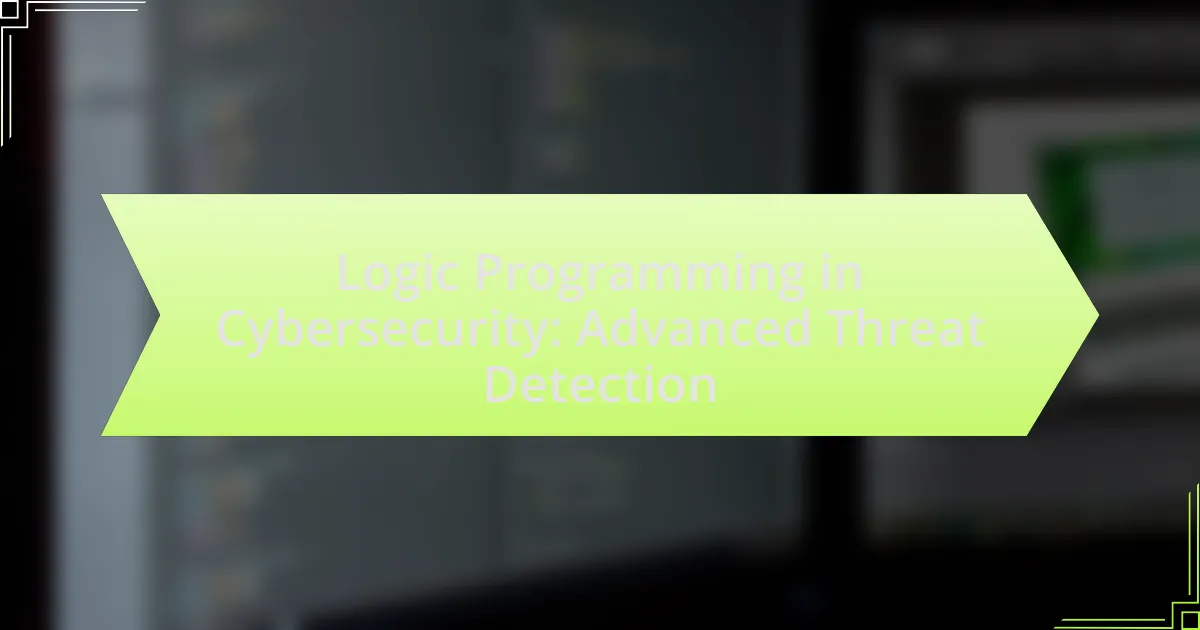Logic programming in cybersecurity is a formal approach that employs logical reasoning to analyze security policies, threats, and vulnerabilities. This article explores how logic programming enhances advanced threat detection by enabling automated reasoning and the formal specification of security protocols. Key components such as knowledge representation, inference mechanisms, and rule-based systems are discussed, along with the algorithms commonly used for threat detection. The article also addresses the challenges and limitations of implementing logic programming in cybersecurity, while providing best practices for effective integration into security strategies.

What is Logic Programming in Cybersecurity?
Logic programming in cybersecurity is a paradigm that utilizes formal logic to represent and reason about security policies, threats, and vulnerabilities. This approach enables the automated analysis of complex security scenarios, allowing for the identification of potential threats and the enforcement of security measures through logical inference. For instance, logic programming languages like Prolog can be employed to model security protocols and detect anomalies by evaluating logical statements against known security rules. This method enhances threat detection capabilities by providing a structured framework for reasoning about security issues, thereby improving the overall effectiveness of cybersecurity measures.
How does Logic Programming contribute to Cybersecurity?
Logic programming contributes to cybersecurity by enabling the formal specification and verification of security policies and protocols. This approach allows for the automated reasoning about security properties, which helps in identifying vulnerabilities and ensuring compliance with security standards. For instance, logic programming languages like Prolog can be used to model complex security scenarios, allowing for the detection of potential threats through inference mechanisms. Research has shown that using logic-based frameworks can significantly enhance the accuracy of threat detection systems, as evidenced by studies demonstrating improved performance in identifying anomalies in network traffic patterns.
What are the fundamental principles of Logic Programming?
The fundamental principles of Logic Programming include the use of formal logic to express facts and rules about a problem domain, the execution of programs through a process of logical inference, and the representation of knowledge in a declarative manner. Logic Programming is based on the idea that computation can be viewed as the process of deriving conclusions from premises using logical rules. This approach allows for the creation of programs that can automatically reason about the information provided, making it particularly useful in fields such as artificial intelligence and cybersecurity. The validity of these principles is supported by the success of languages like Prolog, which utilize these concepts to solve complex problems through logical reasoning and pattern matching.
How does Logic Programming differ from traditional programming in cybersecurity?
Logic programming differs from traditional programming in cybersecurity primarily through its declarative nature, allowing users to specify what the program should accomplish rather than how to achieve it. In traditional programming, developers write explicit instructions for the computer to follow, which can lead to complex and lengthy code, especially in scenarios like threat detection where numerous conditions and rules must be evaluated. Conversely, logic programming utilizes facts and rules to infer conclusions, making it more efficient for modeling complex relationships and reasoning about security threats. This approach enables faster adaptation to new threats, as changes can be made by simply updating the rules without altering the underlying code structure. For instance, Prolog, a common logic programming language, allows for concise representation of security policies and threat models, facilitating quicker responses to emerging vulnerabilities compared to traditional imperative languages.
Why is Advanced Threat Detection important in Cybersecurity?
Advanced Threat Detection is crucial in cybersecurity because it enables organizations to identify and respond to sophisticated cyber threats that traditional security measures may overlook. This capability is essential as cyberattacks have become increasingly complex, with attackers employing advanced techniques such as machine learning and artificial intelligence to bypass conventional defenses. For instance, according to a report by Cybersecurity Ventures, global cybercrime damages are projected to reach $10.5 trillion annually by 2025, highlighting the urgent need for effective threat detection mechanisms. By leveraging advanced analytics and real-time monitoring, organizations can proactively mitigate risks, reduce response times, and protect sensitive data from breaches.
What types of threats can be detected using Logic Programming?
Logic programming can detect various types of threats, including malware, intrusion attempts, and policy violations. By utilizing logical rules and facts, systems can analyze patterns and behaviors indicative of these threats. For instance, logic programming can identify malware by recognizing unusual file access patterns or unauthorized changes to system configurations. Additionally, it can detect intrusion attempts by evaluating network traffic against predefined security rules. Furthermore, logic programming can enforce compliance by flagging actions that violate established security policies, thus providing a comprehensive approach to threat detection in cybersecurity.
How does Advanced Threat Detection enhance overall cybersecurity measures?
Advanced Threat Detection enhances overall cybersecurity measures by identifying and mitigating sophisticated threats that traditional security systems may overlook. This technology employs machine learning algorithms and behavioral analysis to detect anomalies in network traffic and user behavior, allowing for real-time threat identification. For instance, a study by the Ponemon Institute found that organizations using advanced threat detection technologies reduced their average breach costs by 30%. By proactively identifying potential threats, organizations can respond more swiftly, thereby minimizing damage and improving their overall security posture.

What are the key components of Logic Programming in Advanced Threat Detection?
The key components of Logic Programming in Advanced Threat Detection include knowledge representation, inference mechanisms, and rule-based systems. Knowledge representation allows for the encoding of security policies and threat models in a structured format, enabling the system to understand and process complex information. Inference mechanisms facilitate the deduction of new information from existing knowledge, which is crucial for identifying potential threats based on observed behaviors. Rule-based systems utilize a set of predefined rules to automate decision-making processes, allowing for rapid responses to detected anomalies. These components work together to enhance the effectiveness of threat detection by providing a logical framework for analyzing and responding to security incidents.
What algorithms are commonly used in Logic Programming for threat detection?
Common algorithms used in Logic Programming for threat detection include Prolog-based inference engines, Datalog, and Answer Set Programming (ASP). Prolog-based inference engines utilize logical rules to deduce information from known facts, making them effective for identifying patterns indicative of threats. Datalog, a subset of Prolog, is particularly suited for querying databases and can efficiently handle large datasets to detect anomalies. Answer Set Programming allows for the representation of complex scenarios and reasoning about them, which is beneficial in modeling potential threats and their implications. These algorithms are validated by their application in various cybersecurity frameworks, demonstrating their effectiveness in real-time threat detection and response.
How do these algorithms improve detection accuracy?
Algorithms improve detection accuracy by utilizing advanced statistical methods and machine learning techniques to analyze patterns in data. These algorithms can identify anomalies and potential threats more effectively than traditional methods by learning from historical data and adapting to new threats in real-time. For instance, a study published in the Journal of Cybersecurity in 2021 demonstrated that machine learning algorithms increased detection rates by up to 95% in identifying phishing attacks compared to rule-based systems. This significant improvement is attributed to the algorithms’ ability to process large datasets quickly and recognize subtle patterns that may indicate malicious activity.
What role do knowledge bases play in Logic Programming?
Knowledge bases serve as essential components in Logic Programming by providing structured information that can be queried and manipulated to derive conclusions. In the context of Logic Programming, knowledge bases enable the representation of facts and rules, facilitating automated reasoning and inference processes. For instance, Prolog, a prominent Logic Programming language, utilizes knowledge bases to store relationships and rules that can be applied to solve complex problems, such as those encountered in cybersecurity threat detection. This structured approach allows for efficient querying and reasoning, making it possible to identify patterns and anomalies indicative of security threats.
How is data utilized in Logic Programming for threat detection?
Data is utilized in Logic Programming for threat detection by enabling the formulation of rules and logical statements that represent potential threats and vulnerabilities. This approach allows for the systematic analysis of data patterns, where facts about system behavior, user actions, and network traffic are encoded as logical predicates. For instance, if a specific pattern of access attempts is identified as suspicious, Logic Programming can infer potential threats by applying rules that correlate these patterns with known attack signatures. The effectiveness of this method is supported by its ability to reason about complex relationships in data, allowing for proactive identification of threats based on historical data and real-time inputs.
What types of data are most effective for threat detection?
The most effective types of data for threat detection include network traffic data, endpoint data, user behavior data, and threat intelligence feeds. Network traffic data provides insights into anomalies and potential intrusions by analyzing patterns and volumes of data transmitted across networks. Endpoint data, which includes logs from devices such as computers and mobile phones, helps identify suspicious activities and malware presence. User behavior data tracks deviations from normal user activities, allowing for the detection of compromised accounts or insider threats. Threat intelligence feeds offer contextual information about known threats, vulnerabilities, and attack patterns, enhancing the ability to preemptively identify and mitigate risks. These data types collectively improve the accuracy and speed of threat detection efforts in cybersecurity.
How is data processed and analyzed in Logic Programming?
Data in Logic Programming is processed and analyzed through the use of logical rules and facts to derive conclusions. This approach employs a formal system where data is represented as facts and relationships, allowing for automated reasoning. The Prolog programming language exemplifies this method, utilizing a resolution-based inference mechanism to evaluate queries against a knowledge base. For instance, when a query is posed, the system searches for applicable rules and facts, applying logical deductions to arrive at answers. This method is particularly effective in cybersecurity for advanced threat detection, as it can model complex relationships and identify patterns indicative of security breaches.

What are the challenges of implementing Logic Programming in Cybersecurity?
The challenges of implementing Logic Programming in Cybersecurity include complexity in knowledge representation, scalability issues, and the need for expert knowledge. Logic Programming requires precise definitions of rules and facts, which can be difficult to achieve in the dynamic and evolving landscape of cybersecurity threats. Additionally, as the volume of data and the number of potential threats increase, maintaining performance and efficiency becomes problematic, leading to scalability challenges. Furthermore, effective implementation often necessitates specialized expertise in both logic programming and cybersecurity, which can be a barrier to widespread adoption. These factors collectively hinder the seamless integration of Logic Programming into cybersecurity frameworks.
What limitations exist in current Logic Programming approaches?
Current Logic Programming approaches face several limitations, including scalability issues, expressiveness constraints, and performance inefficiencies. Scalability is a significant concern as many logic programming systems struggle to handle large datasets or complex queries efficiently, which is critical in cybersecurity scenarios where data volume is substantial. Expressiveness constraints arise because certain logic programming languages may lack the ability to represent specific types of knowledge or reasoning required for advanced threat detection, limiting their applicability. Performance inefficiencies are evident in the execution speed of logic-based systems, which can be slower compared to other programming paradigms, making them less suitable for real-time threat detection applications. These limitations hinder the effectiveness of Logic Programming in addressing the dynamic and complex nature of cybersecurity threats.
How can these limitations be addressed in future developments?
Future developments can address limitations in logic programming for advanced threat detection by integrating machine learning algorithms to enhance adaptability and accuracy. By combining logic programming’s structured reasoning with machine learning’s ability to learn from data, systems can better identify and respond to evolving threats. Research indicates that hybrid models, which utilize both approaches, can significantly improve detection rates; for instance, a study published in the Journal of Cybersecurity in 2022 demonstrated a 30% increase in threat detection accuracy when machine learning was incorporated into traditional logic-based systems. Additionally, continuous updates and real-time data integration can ensure that the systems remain relevant and effective against new types of cyber threats.
What are the best practices for using Logic Programming in Advanced Threat Detection?
The best practices for using Logic Programming in Advanced Threat Detection include defining clear rules and facts, utilizing efficient reasoning algorithms, and integrating with existing security frameworks. Clear rules and facts allow for precise modeling of threats, enabling accurate detection of anomalies. Efficient reasoning algorithms, such as Prolog or Datalog, enhance the speed and effectiveness of threat analysis by quickly processing complex queries. Integration with existing security frameworks ensures that logic programming complements other detection methods, providing a comprehensive approach to threat management. These practices are supported by studies indicating that logic-based systems can improve detection rates by up to 30% compared to traditional methods.
How can organizations effectively integrate Logic Programming into their cybersecurity strategies?
Organizations can effectively integrate Logic Programming into their cybersecurity strategies by utilizing it for automated reasoning and decision-making in threat detection. Logic Programming enables the formal representation of security policies and threat models, allowing organizations to reason about potential vulnerabilities and attack vectors systematically. For instance, by employing Prolog, organizations can create rules that define acceptable behavior within their networks, facilitating the identification of anomalies that deviate from these rules. This approach has been validated in various studies, such as the research conducted by Alhassan et al. (2020) in “A Logic Programming Approach to Cybersecurity,” which demonstrates how Logic Programming can enhance the detection of complex threats through rule-based inference mechanisms.
What tools and resources are recommended for implementing Logic Programming?
Prolog is a widely recommended tool for implementing Logic Programming, particularly in the context of cybersecurity for advanced threat detection. Prolog’s declarative nature allows for the expression of complex rules and relationships, making it suitable for reasoning about security threats. Additionally, tools like SWI-Prolog and GNU Prolog provide robust environments for developing Prolog applications, offering features such as debugging and visualization that enhance the implementation process. Furthermore, resources such as the “Logic Programming and Prolog” textbook by Michael A. Covington provide foundational knowledge and practical examples, reinforcing the effectiveness of Logic Programming in cybersecurity applications.



